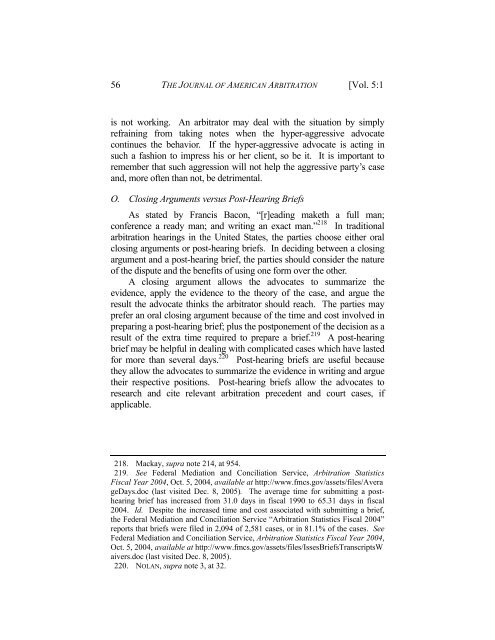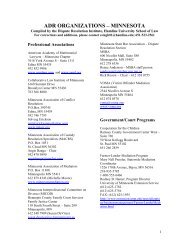2006/Vol. 5 No.1 - Hamline Law - Hamline University
2006/Vol. 5 No.1 - Hamline Law - Hamline University
2006/Vol. 5 No.1 - Hamline Law - Hamline University
Create successful ePaper yourself
Turn your PDF publications into a flip-book with our unique Google optimized e-Paper software.
56 THE JOURNAL OF AMERICAN ARBITRATION [<strong>Vol</strong>. 5:1<br />
is not working. An arbitrator may deal with the situation by simply<br />
refraining from taking notes when the hyper-aggressive advocate<br />
continues the behavior. If the hyper-aggressive advocate is acting in<br />
such a fashion to impress his or her client, so be it. It is important to<br />
remember that such aggression will not help the aggressive party’s case<br />
and, more often than not, be detrimental.<br />
O. Closing Arguments versus Post-Hearing Briefs<br />
As stated by Francis Bacon, “[r]eading maketh a full man;<br />
conference a ready man; and writing an exact man.” 218 In traditional<br />
arbitration hearings in the United States, the parties choose either oral<br />
closing arguments or post-hearing briefs. In deciding between a closing<br />
argument and a post-hearing brief, the parties should consider the nature<br />
of the dispute and the benefits of using one form over the other.<br />
A closing argument allows the advocates to summarize the<br />
evidence, apply the evidence to the theory of the case, and argue the<br />
result the advocate thinks the arbitrator should reach. The parties may<br />
prefer an oral closing argument because of the time and cost involved in<br />
preparing a post-hearing brief; plus the postponement of the decision as a<br />
result of the extra time required to prepare a brief. 219 A post-hearing<br />
brief may be helpful in dealing with complicated cases which have lasted<br />
for more than several days. 220 Post-hearing briefs are useful because<br />
they allow the advocates to summarize the evidence in writing and argue<br />
their respective positions. Post-hearing briefs allow the advocates to<br />
research and cite relevant arbitration precedent and court cases, if<br />
applicable.<br />
218. Mackay, supra note 214, at 954.<br />
219. See Federal Mediation and Conciliation Service, Arbitration Statistics<br />
Fiscal Year 2004, Oct. 5, 2004, available at http://www.fmcs.gov/assets/files/Avera<br />
geDays.doc (last visited Dec. 8, 2005). The average time for submitting a posthearing<br />
brief has increased from 31.0 days in fiscal 1990 to 65.31 days in fiscal<br />
2004. Id. Despite the increased time and cost associated with submitting a brief,<br />
the Federal Mediation and Conciliation Service “Arbitration Statistics Fiscal 2004”<br />
reports that briefs were filed in 2,094 of 2,581 cases, or in 81.1% of the cases. See<br />
Federal Mediation and Conciliation Service, Arbitration Statistics Fiscal Year 2004,<br />
Oct. 5, 2004, available at http://www.fmcs.gov/assets/files/IssesBriefsTranscriptsW<br />
aivers.doc (last visited Dec. 8, 2005).<br />
220. NOLAN, supra note 3, at 32.
















